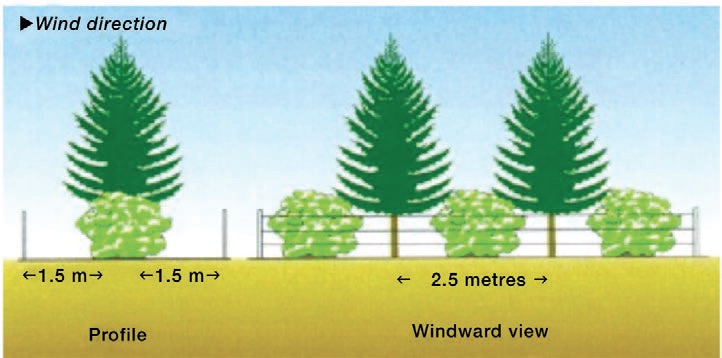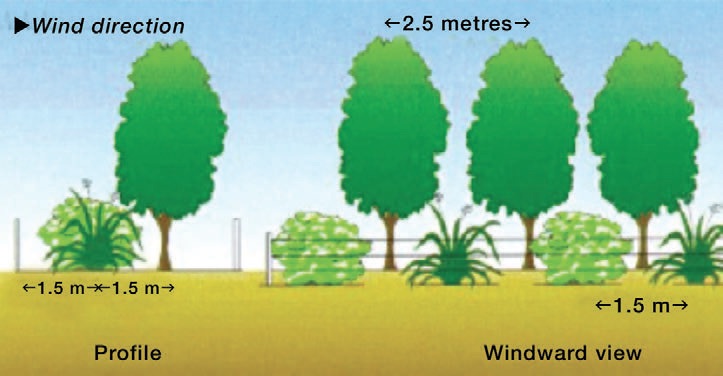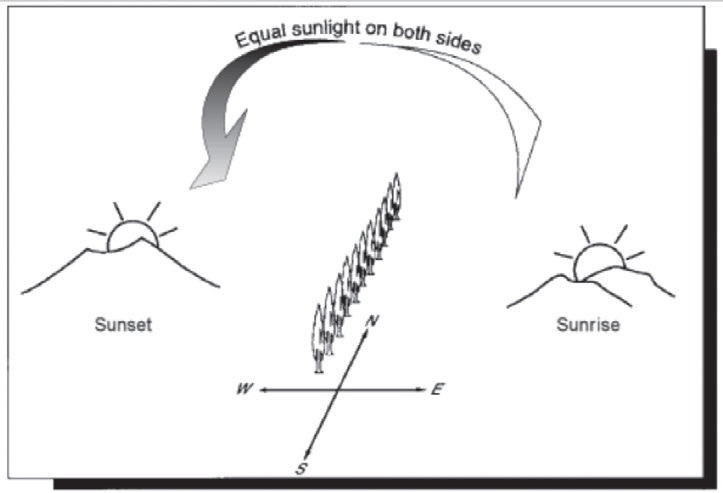Shelter design – what is best for your land?
Hawkes Bay Regional Council, New Zealand Tree Grower May 2011.
This article is the first in a feature on shelter which will run in the next few issues of Tree Grower.
The main purpose of farm shelter is to protect livestock, pasture and crops from the wind, but the benefits of a well-designed shelter belt are many and varied. Shelter has many uses because it not only shelters stock and crops but also −
- Reduces the risk of wind erosion on cultivated soils
- Minimises moisture loss from plants and soil
- Protects buildings and yards and provides shade
- Provides a source of fodder during droughts
- Increases biodiversity, food and habitat for birds, bees and insects, with windbreaks linking remnant native stands able to act as wildlife corridors
- Enhances the landscape, particularly if the layout follows the curved lines of the natural landscape
- Provides a source of timber and firewood.
Shelter from cold winds reduces the energy requirements of livestock, especially during rain and snow, improving growth rates, livestock yields and productivity. Mortality rates in newborns can also be reduced as a result of shelter from the wet and cold. Combining pre-lamb shearing and windbreaks is one way of reducing lambing losses. Ewes that have been shorn are more likely to look for shelter, taking their lambs with them to the protection of the trees. Shelter trees also provide valuable shade, important in preventing heat stress, which has been found to reduce fertility in sheep and affects the well-being and size of calves.
Good windbreak design and layout can achieve a considerable amount of shelter with only a small percentage of land under trees. Because shelterbelts can be expensive to establish, they need to be sited correctly.
 Research has shown −
Research has shown −
- Sheltered areas are mainly governed by the height of the shelterbelt, with tall narrow belts more efficient than wide ones
- Shelterbelts with 40 per cent to 50 per cent porosity reduce wind speeds over the greatest distances as wind accelerates through gaps, around the ends of belts and over dense barriers
- To shelter the greatest area, shelterbelts should be tall, permeable, unbroken and as long as possible, two row designs using different species with different maturing ages can provide a continuity of shelter.
- Careful establishment will promote good even growth rates and avoid losses leading to gaps, with silviculture contributing to the effectiveness of the shelter and adding to the value of the trees at maturity.
Planning





Planning is essential to successfully match needs, species and site. It is important to know exactly why a tree is being planted before beginning to design a shelter system for your farm.
Why do you need shelter? Is your aim to provide maximum shelter over a small distance, perhaps to protect a small number of stock or a high value horticultural crop? Or are you looking for a smaller, but adequate, shelter effect over a larger area?
What are the climate extremes from which you require protection? Do you require shelter from a particular wind direction? Do these winds vary seasonally? For example, hot, dry north westerlies in the summer and cold south westerlies in the winter.You need to be familiar with the local climate and the topography of your property to establish which areas are the most exposed.
Will competition improve or limit productivity? Planting shelterbelts can introduce competition between the trees, soil and pasture or crops for light, water and nutrients. Productivity will sometimes be improved as a result of competition, for example where soil is waterlogged, but you need to establish whether to encourage or restrict competition for water, nutrients and light.
Producing the plan
Draw up a tree planting plan for the farm before starting any planting. Planning must consider a range of objectives and other issues which will affect the final result
- Which wind direction are you sheltering from?
- What the alternative uses are for the trees such as to provide fodder during droughts.
- What crops and what types of stock will be grazed and what are the fencing requirements?
- Check the topography icluding slope angles and land formations which affect the wind direction and speed
- Look at the soil structure and nutrient deficiencies which affect tree survival and growth
- Wind direction, rainfall, aspect, sunshine, temperatures and frosts are all important
- Wet areas, drainage patterns and stock water access all effect shelter location
- Plant and animal pest control is essential
- The views into and out of the farm are important.
- Access routes for vehicles, stock movement and access to utilities must be considered
- Consider your neighbours and check district and regional council requirements for planting along boundaries and next to public roads
If planting near power lines and pylons check with the network company for the required clearances. Civil aviation regulations prohibit the planting of trees in positions which obstruct commercial airfield flight paths. Similar care should be taken, if shelterbelts are proposed in the vicinity of a farm airstrip and approval may be needed before planting shelterbelts alongside railway lines. You also need to plan when to plant, where to get your plants, the required plant quality and quantity, and maintenance.
The aim of shelter is to filter the wind and slow it down but not stop it entirely so its effect is maximised as far downwind as possible.This is achieved by planning for correct density, height, orientation and continuity.
Shelter design features
Density



When wind hits an impermeable barrier, it is forced up and over, reducing its speed and creating turbulence on the other side, before it carries on and regains normal velocity. An impermeable shelter can accelerate the wind as it whips through gaps and over the top. The best sheltering effect is achieved where there is between 40 and 60 per cent permeability or porosity through the shelter. The shelter then acts as a wind filter rather than a barrier, and provides the maximum area of protection into the paddock.
The ideal density can be achieved by planting trees which have the appropriate natural density. For example, radiata pine has a dense crown while eucalyptus and poplar species have light crowns and are much less dense.
A medium density shelterbelt will provide up to 50 per cent reduction in wind speed 8 to 10 tree heights downwind and some protection out to 20 tree heights away. This general rule of thumb can be used to work out appropriate spacing between shelterbelts. For horticultural crops which require total shelter, closer plantings will be necessary. If you cannot see through a shelterbelt then it is too dense. Side trimming of the shelterbelt will help maintain the correct porosity.
Height and orientation
Good shelter will reduce wind velocity by up to half downwind for a distance of 10 to15 times the height of the shelter. For example a 15 metres high shelter will give up to 225 metres of downwind sheltered zone.
Damaging winds often come from more than one direction, so site the shelterbelts carefully. Ideally, shelterbelts should be at right angles to the wind but usually some compromise is needed to fit with existing fence lines or avoid obstacles. Wind velocities can actually be made worse if shelter is angled greater than 40o from the prevailing wind direction.

Plant to minimise shade or to maximise it and ensure falling trees will not damage any structures. If minimisation of shading is important, shelterbelts should be oriented in a north-south direction. By doing so, all paddocks will be exposed to some sun through the day. Where this is not possible, planting deciduous species in an east-west orientation will ensure shading is minimised in winter.
North-south orientated shelter protects against strong, desiccating, westerlies. Tall growing species maximise the effectiveness of the shelter. As shading is not a problem, evergreens can be used.
East-west orientated shelter protects against cold, biting southerlies. Shading on the south side of shelter is a problem with this orientation as the southern side of the belt will receive limited sunlight. This can be reduced by side trimming or using deciduous or light crowned species. They can also cause cold air dams in frosty weather on flat land and valley floors. Low growing, or deciduous species are generally best in this orientation.
Closely planted deciduous trees will give shelter even when bare. On hill country wind may come from a different direction from the prevailing winds as it can funnel up gullies. Do not plant on top of a ridge as this sharpens the ridge increasing the turbulence. It also affects landscape values. Instead, plant shelter below the crest on the leeward or windward side. Plant across, not down, valleys to reduce the funnelling effect of the wind. Finally plant shelter upwind of stockyards and buildings.
Continuity and length
Lack of continuity is one of the major faults with shelter. Wind accelerates through gaps caused by tree losses or gateways, around the ends of shelterbelts and over dense barriers. Turbulence intensifies as shelterbelt density increases, as more wind is deflected around the ends, so one long shelterbelt will be more efficient than a series of shorter ones.

Individual shelter lengths should be at least 12 times, and preferably 24 times, the height of the shelter trees.
To increase the shelter planting length tie in your shelter with other plantings such as woodlots and native bush and use the shape of the land to increase the effective length of the shelterbelt. On flat land work with your neighbours to get the most effective coverage.
Maintain shelter down to ground level to avoid wind funnelling. Trimming encourages foliage growth to ground level in some species. Alternatively, grow low growing species on the windward side of a taller species but ensure permeability is maintained.
Shelter design
Proper design and layout of shelterbelts is important if they are to perform properly. Shelter can be planted as a single or multiple row shelterbelt or it can be a well placed stand of trees. The design selected will depend on the objective of the shelter and its location, and the final choice will depend on the severity of weather conditions, availability of space, financial resources, and personal preference.
The clever placement of a group of trees, rather than a row, can be just as effective. However, understand the wind patterns before contemplating this type of shelter. Single row shelterbelts minimise loss of productive land, but require a high standard of planting and aftercare to ensure uniformity of height and density. Trees need to be closely spaced at two to three metres to prevent draughts at ground level and gaps. This design is used where conditions are not extreme.
A double row is often used where wind is strongest, soils are light and maximum shelter is needed. Double row shelterbelts help achieve effective shelter quicker than planting complementary low growing and high-growing species in a single row.
Plant one row of slow growing and one row of a faster growing species, or plant two rows of the same species. The slow growing windward species provides added stability. Low or slow growing evergreen species maintain branches to ground level without sprawling, providing low winter shelter for stock, and planted as the windward row, shelter tall-growing species in the leeward row while they establish. They can be combined with tall deciduous trees that provide high permeable shelter during the growing season. This design is particularly suitable for boundary shelter as well as situations where it is important to get height quickly while retaining density lower down long term.
Tree spacing for double rows is two to three metres between and within rows with the rows offset to each other. Triple rows are suited for very exposed conditions. Use tough, wind resistant species in all rows.
Timber compromise
Generally shelterbelts do not produce good timber, while trees pruned for timber do not make good shelter. A timberbelt is usually only successful in low wind situations. Options are a single row of trees where alternate trees are fan pruned to provide low shelter and the others are clear pruned for timber.
Pruning correctly and on time is critical to achieving high quality timber, and timber belts should not be thinned, as this destroys their value for farm shelter. On fertile farm sites that are exposed to wind, four to five-year-old physiologically aged cuttings are recommended for pine timber belts. Compared to seedlings, older cuttings are woodier, have a more rigid root system, do not have such bushy crowns and tend to produce a single terminal leader. These traits provide better wind tolerance and growth on fertile farm sites.
Pines in narrow timber belts have faster growth rates than pines in a forest. Timing of operations is therefore less flexible if good timber is to be achieved. Other high-value species such as cypresses are worth considering as are eucalypts which do not require as much silviculture.
Check timber belts regularly and assess the growth and stem diameter to predict pruning times. Look for things that need treating – possum damage, disease, change in growth, form or needle colour, and weeds. Timber belts are easier to prune than woodlots, because they have fewer trees and the trees are easily accessed. However, their open growth form necessitates greater care when pruning, and more attention to timing.
Shelter for horticulture and cropping
Shelter increases crop yield by reducing wind damage and plant transpiration, and increasing soil temperatures. In Canterbury trials, protection from north west winds raised the average yield of oats by 35 per cent in the zone extending to six times their height. Yield of process crops was also greatly improved from shelter. MAF observations showed that good shelter reduced the time required for kiwifruit to come into maximum production by two seasons.
In contrast, crop growth can be depressed directly adjacent to shelterbelts due to added competition for moisture and nutrients. Eucalypts, willows and poplars are notorious species for having extensive root systems which compete with the surrounding crop and can invade tile drains and cause complete blockage. Root pruning every two to three years will help alleviate both of these problems. Where sub-surface drainage crosses under a shelterbelt, the length of pipe 10 to 15 metres out from both sides of the row should be impermeable.
Get expert advice
Shelter can provide further problems for horticultural operations, particularly vineyards. Shelterbelts may impede cold air drainage and attract birds, increasing the risk of frost and bird damage to the crop. Well trimmed shelter will help minimise these problems.
Single row belts are best suited to this land use as they minimise the land taken out of production. The choice of species will depend on site conditions, crop requirements and personal preference.
In designing your shelter belts it is important to take account of local conditions and plant species that will perform well in your location. Contact your local branch of the NZFFA or your regional council for more information, and check out their websites, as most make information and expert advice freely available.

 Farm Forestry New Zealand
Farm Forestry New Zealand